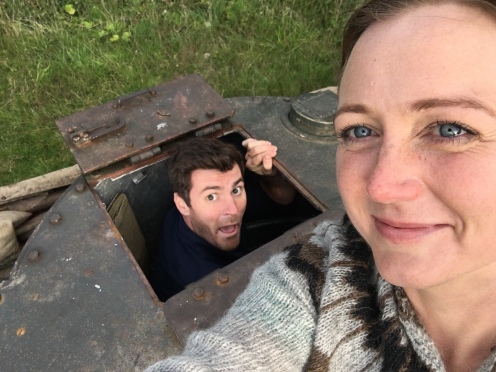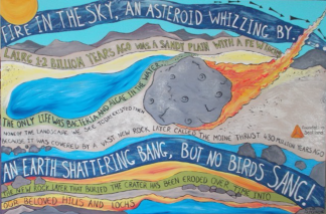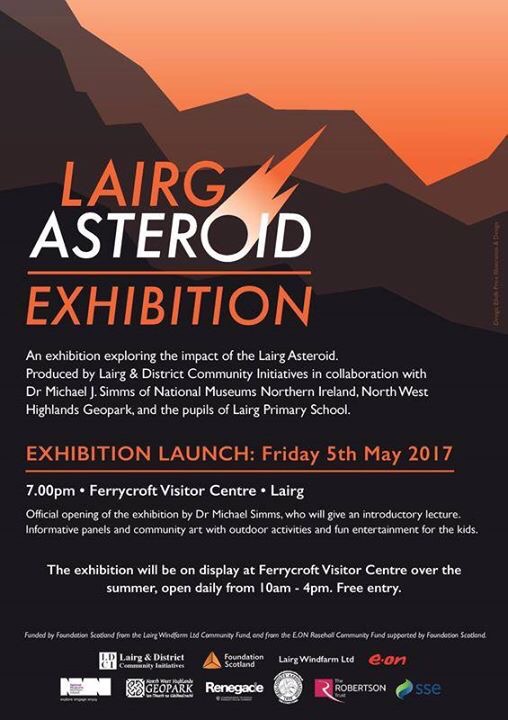
The epic landscape of Northwest Scotland. (c) Adrian Glover
One day, in 2006, while waiting for his own samples to come back from the workshop, Oxford University’s Ken Amor decided to take a look at some thin sections from his departments teaching collection…
“…that was when I found my first grain of shocked quartz. I remember thinking at the time that at that moment I was the only person in the world of 7 billion to realise that the UK had been struck by an asteroid 1.2 billion years ago. Actually I didn’t tell my supervisor for two days because I wanted to hold onto that discovery moment for a little longer.” –Ken Amor, 2016
Those thin sections — infinitesimally thin slices, viewed under a microscope to reveal the rock’s internal structure– were from rocks collected at Stoer Bay in Northwest Scotland.
This bay, beside a scattering of crofters cottages and a ruined Thomas Telford church, is famous amongst geologists because, until recently, and despite 100 years of study, the sediments at Stoer just didn’t make sense.
In particular, one section of the rocks — known as the Stac Fada Member — was a puzzle. Wedged between layers of Torridonian Sandstone, and flecked with tiny fragments of greenish glass, it told of some event that was hot enough to melt rock (that glass!) and powerful enough to force itself between layers of sand, folding them in dramatic fashion as it did so.
A volcanic mudflow, or lahar, seemed like the best explanation. However, there was no evidence of other volcanic activity in the region around that time period.
In 2006, Ken Amor was beginning a DPhil at Oxford, investigating a possible asteroid impact crater at the Triassic/Jurassic boundary. As postgraduate students do, he acted as a demonstrator for the first year undergraduate field trip to northwest Scotland, and as countless other undergraduate field trips have done before and since, they stopped at Stoer:
“I was immediately struck by the textural similarity of the green devitrified glass and a piece of the 15 million year old suevite from the Ries impact crater in Germany… It was at this point standing on the outcrop in Stoer that I first had the idea that the Stac Fada might have an impact origin.”–Ken Amor, 2016
To test this, Ken needed microscopic evidence. The presence of shocked quartz would indicate that the Stac Fada member was material — or ‘ejecta’ — flung far and wide by an asteroid impact, and not volcanic in origin. He didn’t really expect to find any: after all this region is one of the most studied in the world, and a mecca for geologists.
“How many countless eyes of undergraduates had looked at these very same thin sections over several decades and not spotted anything unusual in the quartz grains…?”–Ken Amor, 2016
Nevertheless, there they were: shocked quartz grains in the Stac Fada member. Ken’s hunch appeared to be right — Stac Fada was, indeed, impact ejecta. This discovery changed the course of Ken’s DPhil research, and would go on to rewrite the geological history of Britain:
1.2 billion years ago an asteroid hit the UK, somewhere in the vicinity of Stoer Bay.
But where?
~

Me with Mike Simms at Second Coast, sitting atop a layer of boulders (aka spallation) flung far and wide by the 1.2 billion year old asteroid impact (c) Renegade Pictures/Channel 4
I first met Mike Simms when I was over in Belfast to look at the Ulster Museum’s collection of Sicilian dwarf elephants. That is another story. This story, the story of Scotland’s lost asteroid crater, began over tea and biscuits when Mike told me about his upcoming holiday to Assynt.
Mike Simms is the Curator of Palaeontology at the Ulster Museum. He is a proper, old skool, Natural Historian, with expertise that runs from lichens to speleology to fossils. Much of his personal collection of fossils, collected since childhood, can now be found in the collections of the Natural History Museum in London. And like any proper Natural Historian, he has a thing for rocks.
When Mike read Ken Amor’s 2008 paper identifying the Stac Fada Member as impact ejecta, the only such deposit in the UK, those particular rocks jumped up his list of must-see places. So in June 2011, on a holiday with fellow geology enthusiast Geoff Steel, Mike insisted that they went to see the Stac Fada member for themselves.
“I had never intended to spend years on research into a 1.2 billion year old meteorite impact deposit in Scotland. I had just wanted to visit a couple of sites, pay homage to a remarkable event, collect a few lumps of it, and then on to other things.”–Mike Simms, 2015
But at a place called Second Coast, south of Ullapool, Mike saw something that stopped him in his tracks:
“It was the large angular blocks at Second Coast. Embedded in fairly well-sorted sandstone they were so profoundly anomalous. How could any geologist not wonder how they had got there? I knew enough about impact processes to realise that they could be spallation ejecta, launched at high speed from the perimeter of the impact. It’s the same process that launches meteorites from Mars and the Moon.”–Mike Simms, 2016
These blocks, formed of chunks of three billion year old Lewissian Gneiss, sat in the finely-grained sandstone that underlay the Stac Fada Member. Big heavy blocks that could not have been transported there by the gentle forces that laid down the sand around them. Mike’s explanation? They were the first wave of destruction let loose by the asteroid impact, chunks of bedrock torn and tossed asunder. They would have rained down from the sky, before — seconds later — being covered by the roiling mixture of melted and unmelted rock, buoyed on a superheated cushion of steam, that is now the Stac Fada Member.
And that might have been that. After all, simply adding this piece of extra detail to the Stac Fada impact ejecta story would have a been a satisfying, and unexpected, bonus to any holiday. And Mike and Geoff had a ferry to Lewis to catch. It was certainly enough to Mike decide to come back and look at the Stac Fada exposures, in more detail. It was on this second trip, in September 2011, that Mike realised he might be on to something bigger…
~

Mike Simms at Stoer Bay in 2012 (c) Geoff Steel
Twenty five miles up the coast, at Stoer Bay, the force of the impact ejecta — and the effect of the cushion of steam that carried it forth — can be seen in the dramatic folding of the sandstone layers around the Stac Fada Member. Steam became trapped in the mudstone layers, before exploding out and tearing layers of sand apart, while the impact eject was forced between those layers like great wedges.
When Mike saw those wedges he realised he could work out the direction that the impact ejecta had come from. But he had to wait until a return visit in September of the same year to properly puzzle it out (that ferry to Lewis couldn’t wait!). The wedges thinned out towards the west, and so must have been travelling from a point of impact somewhere to the east. Inland.
This meant the impact crater could still be there.
“When I realised the stuff had come from the east, I figured that the only possible way to find a crater beneath the Moine Thrust was using geophysics. I knew that impact craters commonly are associated with gravity lows, but really didn’t expect to find anything still there. But I thought it might be worth taking a look at the BGS gravity map of the UK.”–Mike Simms, 2016
You may be surprised to learn that gravity actually varies very slightly across the surface of the earth, in relation to the density of the rock in each area. This is because gravitational pull is related to the mass of an object (just imagine holding two similar sized lumps of rock in your hand: one made of chalk, the other granite. The granite is heavier because it is denser, and has more mass). So an area with lots of chalk, like the White Cliffs of Dover, has lower gravity than an area like the Isle of Lewis whose bedrock is the dense Lewisian Gneiss. If an asteroid left a crater in the middle of some dense Lewisian Gneiss 1.2 billion years ago, as the boulders at Second Coast suggested, that crater would have rapidly been infilled with less dense Torridonian sandstone, leaving a tell-tale zone of lower gravity.
But 1.2 billion years is an awful lot of time, and thanks to plate tectonics, the Earth’s surface does not lie dormant. Between 410 and 430 million years ago the continents collided, closing the ancient Iapetus Ocean and uniting the rocks of what is now Scotland and England for the first time. In the process Scotland was compressed, with the rocks to the east thrust up and over those to the west, building mountains in the process. The effects of this can still be seen today, particularly in the Assynt region, where one billion year old Moine schists (a metamorphic rock) sit on top of half a billion year old limestones. These same Moine schists would have been pulled, like a shroud, over any impact crater, potentially destroying it in the process.
They hadn’t.
“I still remember clearly that moment when I pulled the rather crumpled map out of the drawer and saw the gravity low in just the place where I predicted a crater might be. That moment in research when you realise that you are the first person to see something for what it really is… Nothing compares with that.” –Mike Simms, 2016
What Mike saw on that British Geological Survey May was an area known as the Lairg Gravity Low, named for the small sheep market town at its centre.
And now Mike had an explanation for it: it was his impact crater.
He just had to convince everyone else.
~

The zircon is shown here in in red. The yellow lamellae that cut across the zircon are reidite. The phases have been identified using a technique called “electron backscatter diffraction”. Image from Steven Reddy (Curtin University).
Ken Amor’s identification of the Stac Fada member as impact ejecta hadn’t been universally welcomed.
“After the paper was published [in 2008] I did hear of a few anecdotal stories of geologists who went apoplectic at the news and refused to believe in an impact origin for the Stac Fada. Science can get very emotional at times!” —Ken Amor, 2016
Subsequent research by Gordon Osinski, Lousia Preston and colleagues indicated that the amount of shocked quartz present in the Stac Fada sediments was much, much less than that found in other terrestrial impact ejecta, and concluded that it could be better explained as volcanic material that had been transported by water.
And so it was that three years on from Ken’s publication, as Mike was making his own discoveries, the asteroid impact origins of the Stac Fada Member were still a highly debated topic. On top of this Mike wasn’t an impact crater specialist. Together, this set the bar high for having his research accepted by the scientific community.
“I’ve read a great deal about impact craters so was in a position to look at various features with fresh eyes. But the manuscript was rejected by several journals before it was finally published. A couple of arch-critics of the impact theory reviewed the manuscript for the journal in which it finally appeared (PGA). Their comments were immensely helpful, enabling me to address many of the issues that they and others raised and strengthen my arguments still further.” —Mike Simms, 2016
It was just after Mike had received those helpful comments from his reviewers that he and I sat down for tea and biscuits in the Ulster Museums offsite store. Rather than get cross, or whinge about the review process, or even try to find a way to weasel out of addressing the reviewers comments, Mike was gearing up for another trip to Assynt to collect more data. And as I asked him about his upcoming ‘holiday’, I could feel how excited he was. It was palpable. And when he filled my in on the backstory, I could see why. There was a lot to play for.
But on top of his own data, Mike also had to contend with criticisms levelled at the impact ejecta theory itself, and there was nothing he could do about that: his field observations related to the direction the Stac Fada member was travelling when it was deposited, not its ultimate origins. So he could collect all the extra data in the world, but without definitive proof of an asteroid impact in the region, he was sunk.
“The suggestion that I have made, that the Lairg Gravity Low is actually a buried impact crater, would be quite unwarranted were it not for the existence of a thick and extensive impact ejecta layer, the Stac Fada Member, just a few tens of kilometres to the west…”–Mike Simms, 2015
Fortunately for Mike, another group of scientists were addressing this problem at exactly the same time.
~
Steven Reddy and Tim Johnson from Curtin University, Australia, had taken a closer look at shocked zircon grains within the Stac Fada member. Viewing the grains with a scanning electron microscope, and analysing the structure of those grains in fine detail, they identified the presence of an extremely rare mineral known as reidite within the zircon grains themselves.
Reidite (ZrSiO4) is only formed at incredibly high pressures, and these pressures are only experienced at the Earth’s crust in the event of an asteroid impact. The discovery of reidite in the Stac Fada Member was unequivocal proof that it was impact ejecta.
Ken Amor was right. An asteroid had hit NW Scotland 1.2 billion years ago.
It was now up to Mike to make his case for exactly where that impact had occurred.
~

Regional geology of north-west Scotland showing relationship of the Stoer Group, and directional features within it, to the Lairg Gravity low and the Moine Thrust. The radial dotted lines are projected from key Stoer Group sites to the centre of the Lairg Gravity Low. From Simms (2015)
Over the course of four years, Mike visited every single exposure of Stac Fada. At each site he meticulously observed and recorded the features that provided directional evidence. From those wedges of ejecta at Stoer, to the orientation of malteser-like pimples known as ‘accretionary lapilli’* at Enard Bay, it all pointed in the same direction: towards Lairg. His final trip, in 2015, clinched it, and his paper was accepted for publication.
By identifying the Lairg Gravity Low as an impact crater, and measuring it (over 40km wide), Mike was able to estimate the size of the asteroid that hit Britain 1.2 billion years ago. At 3km in diameter, this puts it in the top 20 worldwide of known asteroid impacts.
So is that case closed for Scotland’s Lost Asteroid? Well, not quite.
“A borehole is needed to prove beyond doubt, but I think the evidence from the impact deposit ties in very well with the [Lairg Gravity Low]…it can account for all of the observations on the coast and at Lairg. This is how science should proceed; I have used evidence to suggest an internally consistent hypothesis, which ultimately can be tested”–Mike Simms, 2016
Anyone up for digging a borehole?
~~~~
*accretionary lapilli are basically hail stones made of, well, stone. They are formed, layer upon concentric layer, in turbulent, superheated dust clouds until they fall to the ground under their own weight. Their presence is yet another illustration of just how apocalyptic the conditions must have been when the Stac Fada member was deposited.
~~~~~~~~~~~~~~~~~~~~~~~~~~~~~~~~~~~~~~~~~~~~~~~~~~~~~~~~~~~~~~~~~~~~~~~~
Walking Through Time: Scotland’s Lost Asteroid is on at 8pm, 24th September, Channel 4
Refs:
Amor, K., Hesselbo, S.P., Porcelli, D. et al., (2008). A precambrian proximal ejecta blanket from Scotland. Geology, 36 (4). Free to access here
Simms, M.J. (2015). The Stac Fada impact ejecta deposit and the Lairg Gravity Low” evidence for a buried Precambrian impact crater in Scotland? Proceedings of the Geologists’ Association, 126 (6). Free to access here
Reddy, S.M., Johnson, T. E., Fischer, S., Rickard, W.D.A., and Taylor, R.J.M. (2015). Precambrian reidite discovered in shocked zircon from the Stac Fada impactite, Scotland. Geology, 43 (10)
Osinski,G. R., Preston, L., Ferrière, L., Prave, T., Parnell, J., Singleton, A., and Pickersgill, A. E. (2011). THE STAC FADA “IMPACT EJECTA” LAYER: NOT WHAT IT SEEMS. 74th Annual Meteoritical Society Meeting (2011). Abstract free to access here
Huge thanks to:
Mike Simms, for being so bloody interesting and clever and for letting me tag along with him for a week in Assynt to make Walking Through Time and benefit from his ingenious work. And for answering even more questions for this blogpost.
Ken Amor, for telling me all about his own eureka moment in 2006, and then answering even more questions. And for being such a good sport about not being featured in the programme itself.
Tim Johnson, for letting me use his SEM images of the Stac Fada quartz grains replete with reidite, both in this blogpost and also on the programme.
Louisa Preston, for bringing her research on the Stac Fada to my attention, and for generally being awesome.
The Walking Through Time team and Rosalind support team, for making the Assynt adventure so special: Nick Clarke Powell, Cressida Kinnear, Pete Allibone, AJ Butterworth, Paul Rigby, Clare Keeley, Adrian Glover, Lilly Herridge and Adam Hayward.
Rosalind Glover, for being the most patient and adventurous of babies, enjoying nappies changes and breastfeeding in some of the most remote and beautiful places in the British Isles.


























